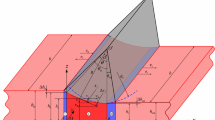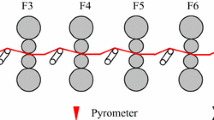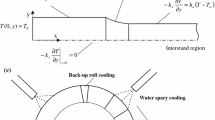Abstract
Accurate calculation of the heat source in the roll gap during the cold rolling process is the basis for a well-designed coolant system, which is particularly important for reducing roll wear and improving the flatness quality of strip steel. Although many established numerical models have high precision when calculating the work roll temperature, complex modeling processes and large calculation times result in the inability to predict the work roll temperature quickly for the application of automatic control systems. Therefore, the authors developed a new analytical heat source model to calculate the axial temperature distribution of the work roll in the cold rolling process. First, according to the deformation characteristics of strip cold rolling, the deformation zone is divided into a plastic zone and two elastic zones, and the length of each deformation zone is calculated considering the effect of tension. Then, the friction heat generated in the elastic zone is calculated. Second, new exponential velocity and corresponding strain-rate fields satisfying kinematically admissible conditions are proposed to calculate the deformation heat and friction heat generated in the plastic zone. Finally, the work roll temperature prediction model is established by contemplating the heat source of the roll gap, emulsion heat transfer, air cooling, and contact heat transfer with the intermediate roll. By repeatedly optimizing the weighted coefficient d of intermediate principal shear stress on the yield criterion, the maximum error between the calculated results and the actual measured cold roll temperature data was reduced to 3.1%. The effects of the reduction ratio, rolling speed, and resistance to deformation on the deformation heat and friction heat are discussed, and the variation of temperature field of the work roll with time is analyzed quantitatively.











Similar content being viewed by others
Availability of data and materials
The datasets used or analyzed during the current study are available from the corresponding author on reasonable request.
Abbreviations
- \(h_{in}\), \(h_{out}\) :
-
Half of the initial and final strip thickness at entry and exit respectively
- \(h_{0}\), \(h_{1}\) :
-
Half of the initial and final strip thickness at entry and exit in plastic zone
- \(h_{mb}\), \(h_{mf}\) :
-
Half of the average strip thickness in backward and forward slip zone
- \(\Delta h_{in}\), \(\Delta h_{out}\) :
-
Half of the reduction in elastic deformation and recovery zones respectively
- \(h_{x}\), \(h_{\alpha }\) :
-
Half of the strip thickness during plastic deformation process
- \(E_{s}\), \(E_{w}\) :
-
Young’s modulus of strip and roll
- \(\nu_{s}\), \(\nu_{w}\) :
-
Poisson ratio of strip and roll
- \(\sigma_{s\,\mathrm{in}}\), \(\sigma_{{s\,{\text{out}}}}\) :
-
Resistance of strip deformation at entry and exit sides
- \(\sigma_{b}\), \(\sigma_{f}\) :
-
Backward and forward tension stresses
- \(\Delta h\) :
-
Half of the reduction in plastic zone
- \(R\) :
-
Original radius of the work roll
- \(R_{0}\) :
-
Flattened roll radius of work roll
- \(l\) :
-
Projected length of roll-strip contact arc in plastic deformation zone
- \(w\) :
-
Strip width
- \(\theta\) :
-
Bite angle
- \(\alpha\) :
-
Contact angle
- \(\alpha_{n}\) :
-
Neutral angle
- \(F_{{{\text{in}}}}^{e}\) :
-
Roll separating force of elastic deformation zone
- \(F_{{{\text{out}}}}^{e}\) :
-
Roll separating force of elastic recovery zone
- \(U\) :
-
Flow volume per second
- \(\mu\) :
-
Friction coefficient
- \(D\left( {\dot{\varepsilon }_{ij} } \right)\) :
-
The power per unit volume
- \(v_{0}\) :
-
Entrance velocity
- \(v_{R}\) :
-
Roll speed
- \(d\) :
-
Yield criterion parameter
- \(\sigma_{s}\) :
-
Material yield stress
- \(\tau_{f}\) :
-
Friction stress
- \(k\) :
-
Yield shear stress,\(k = {{\sigma_{s} } \mathord{\left/ {\vphantom {{\sigma_{s} } {\sqrt 3 }}} \right. \kern-\nulldelimiterspace} {\sqrt 3 }}\)
- \(\dot{W}_{i}\) :
-
Internal plastic deformation power
- \(\dot{W}_{f}^{e}\), \(\dot{W}_{f}^{p}\) :
-
Friction power
- \(Q_{f}^{e}\), \(Q_{f}^{p}\) :
-
Friction heat generated in the elastic zone and plastic zone
- \(Q_{i}\) :
-
Deformation heat
- \(Q_{e}\), \(Q_{a}\) \(Q_{{{\text{int}} er}}\) :
-
Heat exchange between the work roll with emulsion, air, and intermediate roll
- \(t_{r}^{e}\), \(t_{r}^{p}\) :
-
Contact time between roll with strip in the elastic zone and plastic zone
- \(t_{we}\), \(t_{wa}\), \(t_{wi}\) :
-
Contact time between the roll with emulsion, air and intermediate roll
References
Zhang SH, Deng L, Che LZ (2022) An integrated model of rolling force for extra-thick plate by combining theoretical model and neural network model. J Manuf Process 75:100–109
Lenard JG, Pietrzyk M (1989) The predictive capabilities of a thermal model of flat rolling. Steel Res Int 60(9):403–406
Wang GD (1986) Flatness control and flatness theory. Metall Ind Press, Beijing
Wilmote S, Milgnon J (1973) Thermal variations of the caber of the working rolls during hot rolling. Metall Rep CRM 34:17–34
Lahoti GD, Shah SN, Altan T (1978) Computer-aided analysis of the deformations and temperatures in strip rolling. J Eng Ind 100(2):159–166
Nakagawa K (1980) Heat crown of work rolls during aluminum hot rolling. Sum Light Metals Technol Rep 21:45–51
Tseng AA (1984) A numerical heat transfer analysis of strip rolling. J Heat Tran 106(3):512–517
Tseng AA, Tong SX, Maslen SH, Mills JJ (1990) Thermal behavior of aluminum rolling. J Heat Tran 112(2):301–308
Chang DF (1990) An efficient way of calculating temperatures in the strip rolling process. J Manu Sci E-T ASME 120:93–100
Zhang XL, Zhang J, Li XY, Li HX, Wei GC (2004) Analysis of the thermal profile of work rolls in the hot strip rolling process. J Univ Sci Technol Beijing 11(2):173–177
Yang LP, Jiang ZY, Zhu JX, Yu HX (2018) Analysis of transient heat source and coupling temperature field during cold strip rolling. Int J Adv Manuf Tech 95:835–846
Guo ZF, Li CS, Xu JZ, Liu XH, Wang GD (2006) Analysis of temperature field and thermal crown of roll during hot rolling by simplified FEM. J Iron Steel Res Int 13(6):27–30
Benasciutti D, Brusa E, Bazzaro G (2010) Finite element prediction of thermal stresses in work roll of hot rolling mills. Proc Eng 2(1):707–716
Zhang SH, Deng L, Wen TH, Che LZ, Yan L (2022) Deduction of a quadratic velocity field and its application to rolling force of extra-thick plate. Comput Math Appl 109:58–73
Sezek S, Aksakal B, Can Y (2008) Analysis of cold and hot plate rolling using dual stream functions. Mater Des 29(3):584–596
Yu MH, He LN, Liu CY (1992) Generalized twin-shear stress yield criterion and its generalization. Chinese Sci Bull 37(24):2085–2089
Zhao DW, Li J, Liu XH, Wang GD (2009) Deduction of plastic work rate per unit volume for Unified yield criterion and its application. Trans Nonferrous Met Soc China 19:657–660
Zhang YF, Zhao MY, Li X, Di HS, Zhou XJ, Peng W, Zhao DW, Zhang DH (2021) Optimization solution of vertical rolling force using unified-yield criterion. Int J Adv Manuf Tech 119:1035–1045
Wang GD, Wang GL (1990) Iron and Steel Institute of Japan·Rolling theory and experience of the strip steel. Railway Press of China, Beijing
Hosford WF (1983) Metal forming mechanics and metallurgy. Prentice-Hall Inc, Englew ood Cliffs
Sun J, Liu YM, Hu YK, Wang QL, Zhang DH, Zhao DW (2016) Application of hyperbolic sine velocity field for the analysis of tandem cold rolling. Int J Mech Sci 108–109:166–173
Funding
This study was funded by the National Natural Science Foundation of China (No. U20A20187), the LiaoNing Revitalization Talents Program (No. XLYC2007087), and the Fundamental Research Funds for the Central Universities (No. N2124007-1).
Author information
Authors and Affiliations
Contributions
Yufeng Zhang wrote the first draft of the paper. All authors revised and approved the final version of the manuscript.
Corresponding author
Ethics declarations
Competing interests
We declare that we have no financial and personal relationships with other people or organizations that can inappropriately influence our work, there is no professional or other personal interest of any nature or kind in any product, service and/or company that could be construed as influencing the position presented in, or the review of, the manuscript entitled, “A novel analytical heat source model for cold rolling based on the energy method and unified yield criterion”.
Additional information
Publisher's note
Springer Nature remains neutral with regard to jurisdictional claims in published maps and institutional affiliations.
Appendix
Appendix
According to the collinear vector inner product, the friction power \(\dot{W}_{f}^{p}\) is
where \(\alpha\), \(\beta\), and \(\gamma\) are the angles between \(\tau_{f}\) and the directions of the x, y, and z axes.
Since the tangential velocity discontinuity \(\Delta v_{f}\) and the tangent of the roll surface have the same direction, the values of the direction cosines were determined by Eq. (1), and they are
The differential element of the roll surface from Eq. (2) is
The components of tangential velocity discontinuity \(\Delta v_{f}\) on roll surface from Eq. (16) are
By substituting Eqs. (34), (35) and (36) into Eq. (33) and integrating, we obtain
Similarly,
By substituting Eqs. (38) and (39) into Eq. (37) and integrating, Eq. (22) is given.
Rights and permissions
Springer Nature or its licensor holds exclusive rights to this article under a publishing agreement with the author(s) or other rightsholder(s); author self-archiving of the accepted manuscript version of this article is solely governed by the terms of such publishing agreement and applicable law.
About this article
Cite this article
Zhang, Y., Li, X., Zhao, M. et al. Novel analytical heat source model for cold rolling based on an energy method and unified yield criterion. Int J Adv Manuf Technol 122, 3725–3738 (2022). https://doi.org/10.1007/s00170-022-10016-6
Received:
Accepted:
Published:
Issue Date:
DOI: https://doi.org/10.1007/s00170-022-10016-6




